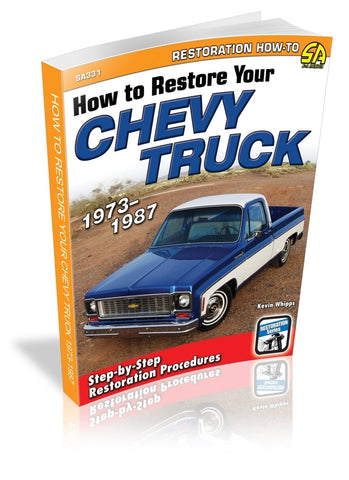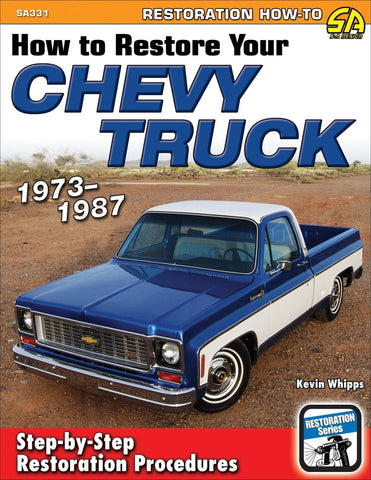Whether your 1973-1987 Chevy truck is a regular, super, or crew cab with a short or long box, this restoration guide provides the pertinent information and instruction to restore your squarebody truck to original condition.
Seasoned truck magazine writer Kevin Whipps explains real-world techniques for restoring classic Chevrolet and GMC trucks at home. In How to Restore Your Chevy Truck: 1973-1987, you are shown how to comprehensively inspect, properly assess, and accurately budget your restoration project. You are also guided through each major portion of truck restoration, including the engine, suspension, chassis, bodywork, paint, brakes, steering, transmission, driveline, electrical system, interior, and more. Special coverage is dedicated to the replacement of body panels and repair of the box, cab, and other body parts. When pro-caliber bodywork has been performed, you have an excellent foundation for the paint, and in turn, you’re shown how to prep, shoot, and buff the paint job. As an on- and off-road utility vehicle, Chevy/GMC trucks have been towing, hauling, and operating in a variety of conditions. After all of these years of hard use and exposure to harsh conditions, many of these extensively used trucks are in desperate need of restoration.
When Chevy released its third-generation C/K pickup trucks, the stout and sturdy performers captured the attention of Chevy and GMC truck enthusiasts. As a result, millions were sold during their 18-year production run. The new cab design featured rounded windshield corners, a rounded cab roof, and sloped and rounded doors, so they were called the “rounded-line” trucks by General Motors. Enthusiasts, however, didn’t agree. Because of the overall squarer appearance of the trucks, they were soon called the “squarebody” by enthusiasts and journalists alike. Although the older Chevy/GMC pickups are more exclusive, the third-generation pickups are plentiful, increasing in collector value, and, fortunately, they have parts that are readily available.
Chevy/GMC trucks are extremely popular as stock restorations, fast street trucks, and off-road-duty trucks. But before you can build a specialty truck, you need to have a solid, reliable, restored truck. This book provides the invaluable information and step-by-step instruction to return these trucks to their original glory. An authoritative and comprehensive restoration guide for the 1973-1987 Chevy/GMC trucks has not been available until now.
Acknowledgments
Introduction
Chapter 1: Finding a Project Squarebody
Overview of the 1973–1987 Chevrolet Pickup
Year-by-Year Changes
Trim Levels
Special Editions
VIN Decoding
The Right Truck for You
Ownership Documents
Customized Versus Stock Trucks
Rust Versus No Rust
Engine and Transmission
Chassis, Suspension, and Brakes
Beater Options
Determining Your Skill Level
Chapter 2: Getting Started
Organizing Your Process
Choosing the Level of Restoration
Setting a Budget
Preparing Your Workspace
NOS Versus Reproduction Versus Aftermarket Parts
Purchasing a Parts Vehicle
Organizing and Cataloging Your Parts
Tools and Equipment
Welding and Metalwork
Consumable Materials and Supplies
Making Your Own Tools
Chapter 3: Bodywork
Installing New Cab Mounts
Body Trim
Stripping the Finish
Inspecting for Rust
Panel Replacement Procedures
Repairing Bed Rust Damage
Repairing Cab Rust Damage
Repairing Dents and Dings
Applying Body Filler
Gapping the Panels
Fixing Factory Issues
Prep for Paint
Chapter 4: Paint
DIY Versus Paying a Professional
Equipment
Paint Types
Paint Colors
Priming
Sealing
Painting Basics
Chapter 5: Engine
Analysis of Work Required
Engine Removal
Engine Installation
Rebuilding Basics
Chapter 6: Transmission
Transmission Types
Tools and Equipment
Removing the Transmission
Disassembling the Transmission
Rebuilding Basics
Chapter 7: Drivetrain
Axle Identification
Gearing
Rebuilding an Axle
Chapter 8: Brakes
Remove or Replace
Brake Lines
Front Disc Brakes
Wheel Bearings
Rear Drum Brakes
Bleeding the Brakes
Chapter 9: Suspension
DIY Versus Paying a Professional
Removal and Installation
Rebuilding Basics
Chapter 10: Electrics
Tools and Equipment
Full-Chassis Harness
Chapter 11: Interior
DIY Versus Paying a Professional
Trim Removal
Interior Disassembly
Interior Reassembly and Refurbishment
Chapter 12: Miscellaneous Mechanicals
Fuel System
Badge and Emblems
Long-Bed to Short-Bed Conversion
Source Guide
Whether your 1973-1987 Chevy truck is a regular, super, or crew cab with a short or long box, this restoration guide provides the pertinent information and instruction to restore your squarebody truck to original condition.
Seasoned truck magazine writer Kevin Whipps explains real-world techniques for restoring classic Chevrolet and GMC trucks at home. In How to Restore Your Chevy Truck: 1973-1987, you are shown how to comprehensively inspect, properly assess, and accurately budget your restoration project. You are also guided through each major portion of truck restoration, including the engine, suspension, chassis, bodywork, paint, brakes, steering, transmission, driveline, electrical system, interior, and more. Special coverage is dedicated to the replacement of body panels and repair of the box, cab, and other body parts. When pro-caliber bodywork has been performed, you have an excellent foundation for the paint, and in turn, you’re shown how to prep, shoot, and buff the paint job. As an on- and off-road utility vehicle, Chevy/GMC trucks have been towing, hauling, and operating in a variety of conditions. After all of these years of hard use and exposure to harsh conditions, many of these extensively used trucks are in desperate need of restoration.
When Chevy released its third-generation C/K pickup trucks, the stout and sturdy performers captured the attention of Chevy and GMC truck enthusiasts. As a result, millions were sold during their 18-year production run. The new cab design featured rounded windshield corners, a rounded cab roof, and sloped and rounded doors, so they were called the “rounded-line” trucks by General Motors. Enthusiasts, however, didn’t agree. Because of the overall squarer appearance of the trucks, they were soon called the “squarebody” by enthusiasts and journalists alike. Although the older Chevy/GMC pickups are more exclusive, the third-generation pickups are plentiful, increasing in collector value, and, fortunately, they have parts that are readily available.
Chevy/GMC trucks are extremely popular as stock restorations, fast street trucks, and off-road-duty trucks. But before you can build a specialty truck, you need to have a solid, reliable, restored truck. This book provides the invaluable information and step-by-step instruction to return these trucks to their original glory. An authoritative and comprehensive restoration guide for the 1973-1987 Chevy/GMC trucks has not been available until now.
Acknowledgments
Introduction
Chapter 1: Finding a Project Squarebody
Overview of the 1973–1987 Chevrolet Pickup
Year-by-Year Changes
Trim Levels
Special Editions
VIN Decoding
The Right Truck for You
Ownership Documents
Customized Versus Stock Trucks
Rust Versus No Rust
Engine and Transmission
Chassis, Suspension, and Brakes
Beater Options
Determining Your Skill Level
Chapter 2: Getting Started
Organizing Your Process
Choosing the Level of Restoration
Setting a Budget
Preparing Your Workspace
NOS Versus Reproduction Versus Aftermarket Parts
Purchasing a Parts Vehicle
Organizing and Cataloging Your Parts
Tools and Equipment
Welding and Metalwork
Consumable Materials and Supplies
Making Your Own Tools
Chapter 3: Bodywork
Installing New Cab Mounts
Body Trim
Stripping the Finish
Inspecting for Rust
Panel Replacement Procedures
Repairing Bed Rust Damage
Repairing Cab Rust Damage
Repairing Dents and Dings
Applying Body Filler
Gapping the Panels
Fixing Factory Issues
Prep for Paint
Chapter 4: Paint
DIY Versus Paying a Professional
Equipment
Paint Types
Paint Colors
Priming
Sealing
Painting Basics
Chapter 5: Engine
Analysis of Work Required
Engine Removal
Engine Installation
Rebuilding Basics
Chapter 6: Transmission
Transmission Types
Tools and Equipment
Removing the Transmission
Disassembling the Transmission
Rebuilding Basics
Chapter 7: Drivetrain
Axle Identification
Gearing
Rebuilding an Axle
Chapter 8: Brakes
Remove or Replace
Brake Lines
Front Disc Brakes
Wheel Bearings
Rear Drum Brakes
Bleeding the Brakes
Chapter 9: Suspension
DIY Versus Paying a Professional
Removal and Installation
Rebuilding Basics
Chapter 10: Electrics
Tools and Equipment
Full-Chassis Harness
Chapter 11: Interior
DIY Versus Paying a Professional
Trim Removal
Interior Disassembly
Interior Reassembly and Refurbishment
Chapter 12: Miscellaneous Mechanicals
Fuel System
Badge and Emblems
Long-Bed to Short-Bed Conversion
Source Guide










